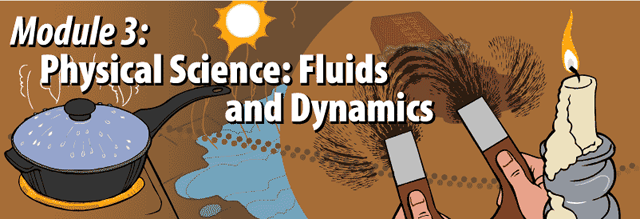Section 1: States of Matter and the Kinetic Molecular Theory Book
Lesson B: States of Matter
http://www.chem4kids.com/files/matter_states.html
This site is written in kid-friendly language. It has everything
to do with matter, and changing states, and related links. It’s
worth checking out!
Lesson C: From One State to Another
Kinetic Molecular Theory
The Structure of Matter
http://www.mpcfaculty.net/mark_bishop/KMT.htm
An animated model of the KMT.
The Structure of Matter
http://www.mpcfaculty.net/mark_bishop/KMT.htm
An animated model of the KMT.
Harcourt School Publishers: States of Matter
http://www.harcourtschool.com/activity/states_of_matter/
A simple animation using a pot of water that changes state
depending on temperature – shows movement of particles.
Section 2: Density
Lesson A: Define and Calculate Density
Density
http://www.visionlearning.com/library/module_viewer.php?mid=37&l=&c3=
This site is great for specific lessons on all aspects found
in this lesson, includes the story of Archimedes.
Archimedes
Mass-Volume-Density
http://www.visionlearning.com/library/module_viewer.php?mid=37&l=&c3=
http://www.edinformatics.com/math_science/mass_volume_density.htm
The following activities target a middle school population
although activities are approachable by more advanced elementary school
students. The activities are also ideal for high school students to review
basic concepts.
Density Lab
Density Lab Gizmo
http://www.explorelearning.com/index.cfm?method=cResource.dspView&ResourceID=17
With a scale to measure mass, a graduated cylinder to measure
volume, and a large beaker of liquid to observe floatation, the relationship
between mass, volume, density, and floatation can be investigated. The
density of the liquid in the beaker can be adjusted, and many different
objects can be studied during the investigation.]
Lesson B: Measuring Mass and Volume
Measuring to use a virtual triple beam balance
Reading a Triple Beam Balance
http://www.wisc-online.com/objects/index_tj.asp?objid=GCH202
An interactive demo that teaches you how to read the mass
of objects using a triple beam balance.
Math and Science Activity Center: Finding the Mass of an Object
http://www.edinformatics.com/math_science/mass.htm
Basic activities and excellent graphics to practice using
a triple beam balance. Also has a link to figuring out the difference
between weight and mass.
Water Displacement
Displacement of Water (Flash animation)
http://www.execulink.com/~ekimmel/density_displacment.htm
This animation shows how a rubber stopper placed in a graduated
cylinder will cause the water level to rise. Since the volume of the
stopper is equal to the volume of water displaced and the initial and
final mass is known, the density of the irregularly shaped stopper can
be determined.
Section 3: The Concept of Force
Lesson A: Types of Force
Newton
ZOOM Sci – Mix hot science with your cool ideas
http://pbskids.org/zoom/activities/sci/
Scroll down to the section Forces and Energy: Move it for
for simple, do at home labs on friction.
Newton’s Laws of Motion
http://www.sciencechannel.com/games-and-interactives/newtons-laws-of-motion-interactive/
Animations on Newton’s three laws of motion.
Newton’s Laws of Motion
http://www.at-bristol.org.uk/Newton/experiment.htm#forces
More animations on Newton’s Laws of Motion.
Section 4: Fluids
Lesson A: Force and Pressure
Diamonds
Diamond Source
http://www.diamondsourceva.com/Education/ArtificialDiamonds/man-made-diamonds.asp
A commercial site that describes the processes
of manufacturing diamonds.
USA Today
http://www.usatoday.com/tech/news/techinnovations/2005-10-06-man-made-diamonds_x.htm
A story about the potential of making diamonds
for retail sales.
National Geographic - How Diamonds are Formed
https://www.youtube.com/watch?v=hY32prGn6B8
A video showing how diamonds are formed.
Explore Learning: Archimedes’ Principle
http://www.explorelearning.com/index.cfm?method=cResource.dspView&ResourceID=603
An interactive activity that demonstrates Archimedes’ Principle
along with some assessment questions to check your understanding.
Lesson C: Natural and Constructed Fluid Systems
Bernoulli
Daniel
Bernoulli
http://www-groups.dcs.st-and.ac.uk/~history/Biographies/Bernoulli_Daniel.html
An interesting account of Bernoulli’s life in the 18th
century.
Weather
How Does a Hurricane Form
http://scijinks.jpl.nasa.gov/weather/howwhy/hurricane/
A simple explanation is provided for how hurricanes
are formed, plus an amazing animation of the forming of Hurricane Katrina.
How do Clouds Form
http://scied.ucar.edu/shortcontent/how-clouds-form
A basic diagram and explanation for how clouds
are formed.
The Weather Network
http://www.theweathernetwork.com/ca
Follow stories about weather in British Columbia.
Environment Canada
http://www.weatheroffice.ec.gc.ca/canada_e.html
Follow stories and get information about weather
in Canada.
Earth’s Crust
Understanding Plate Motions
http://pubs.usgs.gov/gip/dynamic/understanding.html
Useful graphics and illustrations describing how
plates move and how these movements relate to earthquake activity.
Plate Tectonics
http://www.ucmp.berkeley.edu/geology/tectonics.html
Plate tectonics animations depicting different
time periods as well as links to other recommended sites.
Science Odyssey: Mountain Maker, Earth Shaker
http://www.pbs.org/wgbh/aso/tryit/tectonics/#
Lots of activities and information about plate
tectonics. Requires Shockwave to do activities.
The Heart
Heart and Stroke Foundation: Blood Pressure Action Plan
http://www.heartandstroke.com/site/c.ikIQLcMWJtE/b.2796497/k.BF8B/Home.htm
This well-known Canadian site is full of practical information
on how to lead a healthy life and have a healthy heart.
The Heart
http://www.smm.org/heart/heart/top.html
Lessons, animations, videos and lots of facts about the heart.
Respiratory System
The Lung Association
http://sct.poumon.ca/lung101-renseignez/students-etudiants_e.php
Games and interactive website about the human respiratory
system.
Lungs
http://www.smm.org/heart/lungs/top.html
Lessons, animations, videos and lots of facts about the lungs.
|
